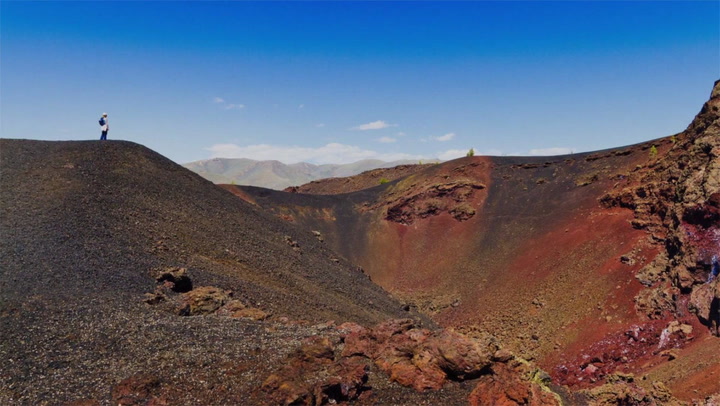Summary
Volcanoes and moonscapes abound at Craters of the Moon National Monument and Preserve.
The Craters of the Moon National Monument and Preserve in central Idaho allows visitors to explore the surface of the moon without ever leaving Earth. The name “Craters of the Moon National Monument” evokes a sense of otherworldly adventure and out-of-this-world scenery. In 1969, Apollo astronauts actually visited the preserve and studied its topography, aiding in their preparation for space exploration. To this day, permits can still be obtained for scientific research in this unique park.
While Craters of the Moon may seem like a uniform landscape at first, the geological variety across the tubes and rivers of cooled lava will surprise and delight you. It’s important to note that you won’t see any huge volcanoes here. Instead, you will find about 25 “cinder cones,” each one qualifying as a distinct but small volcano. The monument’s volcanoes are dormant rather than extinct—however, there are currently no signs indicating impending eruptions.

What to Do at Craters of the Moon National Monument and Preserve
Orbit “Mars on Earth”
Take in the alien views of the monument on the seven-mile loop road. The drive itself isn’t lengthy; however, you’ll definitely want to stop for picturesque views at the various points along the route. Additionally, there are numerous trails leading to and through the volcanic features accessible from the road. Be sure to check out significant craters and fragile spatter cones from stop 5 on the loop road.
Learn to Love the Lava
From the sensationally-named lava bombs to ropes and rows of unique pahoehoe lava, there’s a tremendous amount of diversity to appreciate at the site. Stop number 2 on the loop road is known as North Crater Flow. From the top of the steep North Crater Trail, you can peer right into a lava vent. At stop 6, you can see block lava—large, irregular blocks of lava that are smoother than other types found in the park.
Become a Junior Lunar Ranger
At Craters of the Moon National Monument, kids can fill out an educational and fun activity book and turn it in to earn a cool-looking patch. Finished your activity book after the visitor center closed? No worries—you can mail in your completed booklet to get a junior ranger badge sent to you at home.
Discover a Cave
While there are only a few caves at the monument that are open to the public, the bats in these caves are mesmerizing yet vulnerable to White-Nose Syndrome, a deadly fungus. Although humans aren’t susceptible, they can carry the fungus, which is why cave permits are granted only after visitors undergo a screening process with park staff. This area is the final stop on the loop road.
Come for Wildflower Season
Every spring, vibrant carpets of wildflowers appear, bringing Craters of the Moon to life. Late May to mid-June is typically when the season reaches its peak. Moreover, the syringa, Idaho’s state flower, is a notable mid-summer bloom at the monument. Despite the harsh and seemingly barren environment, stunning flowers make their comeback each year, showcasing an act of stubborn survival.
Admire the Night Sky
Due to light pollution, two out of every three Americans cannot view the Milky Way from their backyards. Craters of the Moon features some of the darkest skies in the national park system. There is a Star Party each fall and spring, and during the summer, you can join ranger-led full moon hikes through the preserve.
Climb a Mountain of Ash
Although it requires some effort to reach the Inferno Cinder Cone viewpoint from the parking lot, the reward is worth it. Conditions can be quite windy during the ascent, so be sure to hold on to your hat! At the summit, you’ll be greeted with breathtaking views of multiple cinder cones against the seismic backdrop of the Great Rift.
Where to Stay Near Craters of the Moon National Monument
A 42-site campground unfolds across the volcanic vista beyond the visitor center. The campground operates on a first-come, first-served basis and costs $15 a night during the season. While there is no lodging available within the park, plenty of options can be found 18 miles east in Arco.
For those keen on adding a quirky and unforgettable attraction to their Idaho itinerary, consider finding lodging three hours away in Pocatello. There, visitors will discover the Museum of Clean, an engaging educational complex that highlights the importance of cleanliness.





